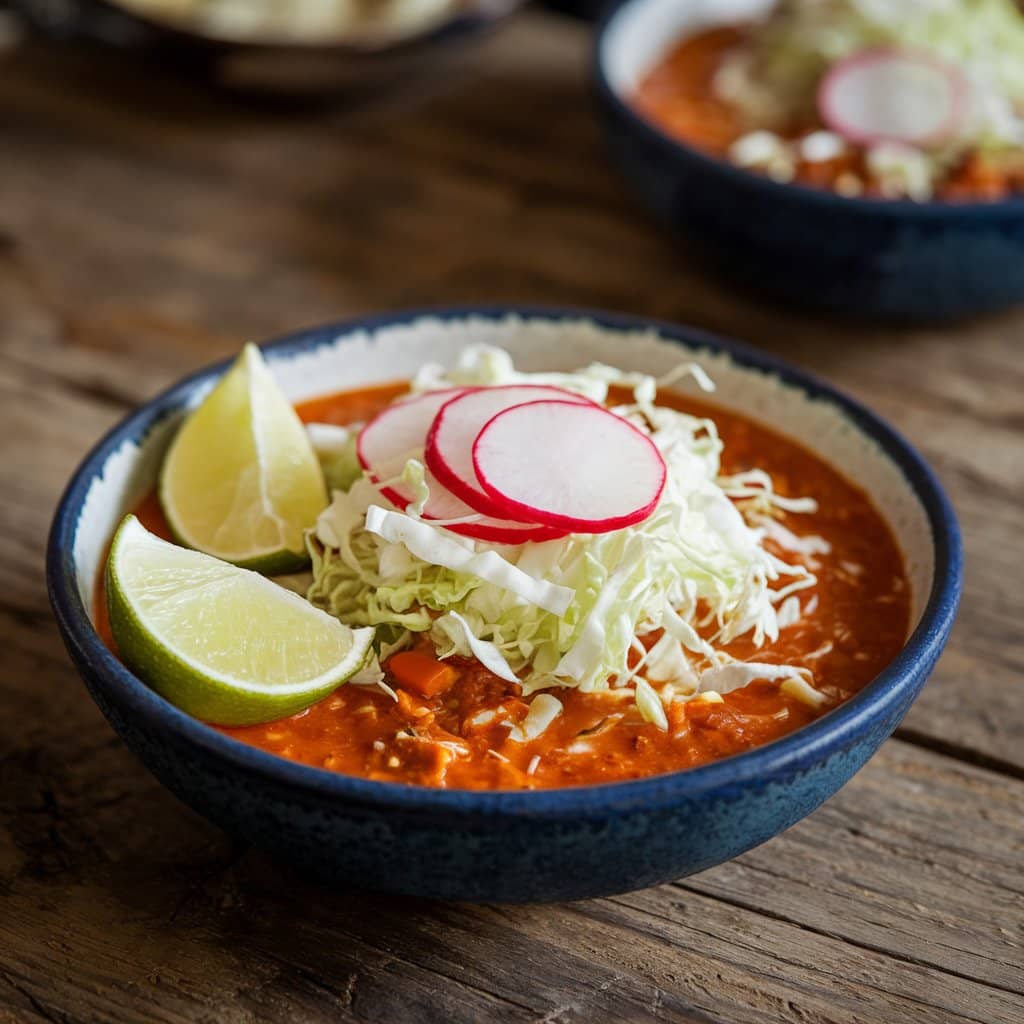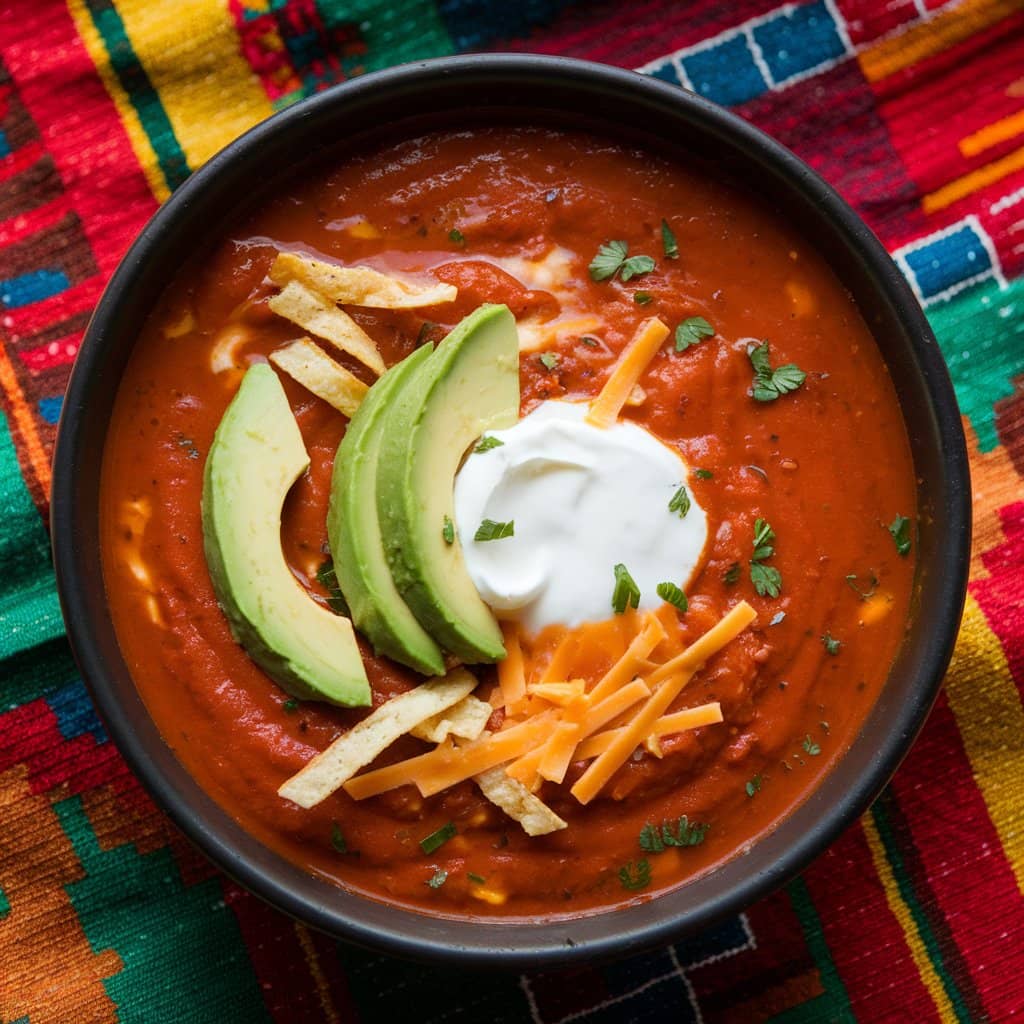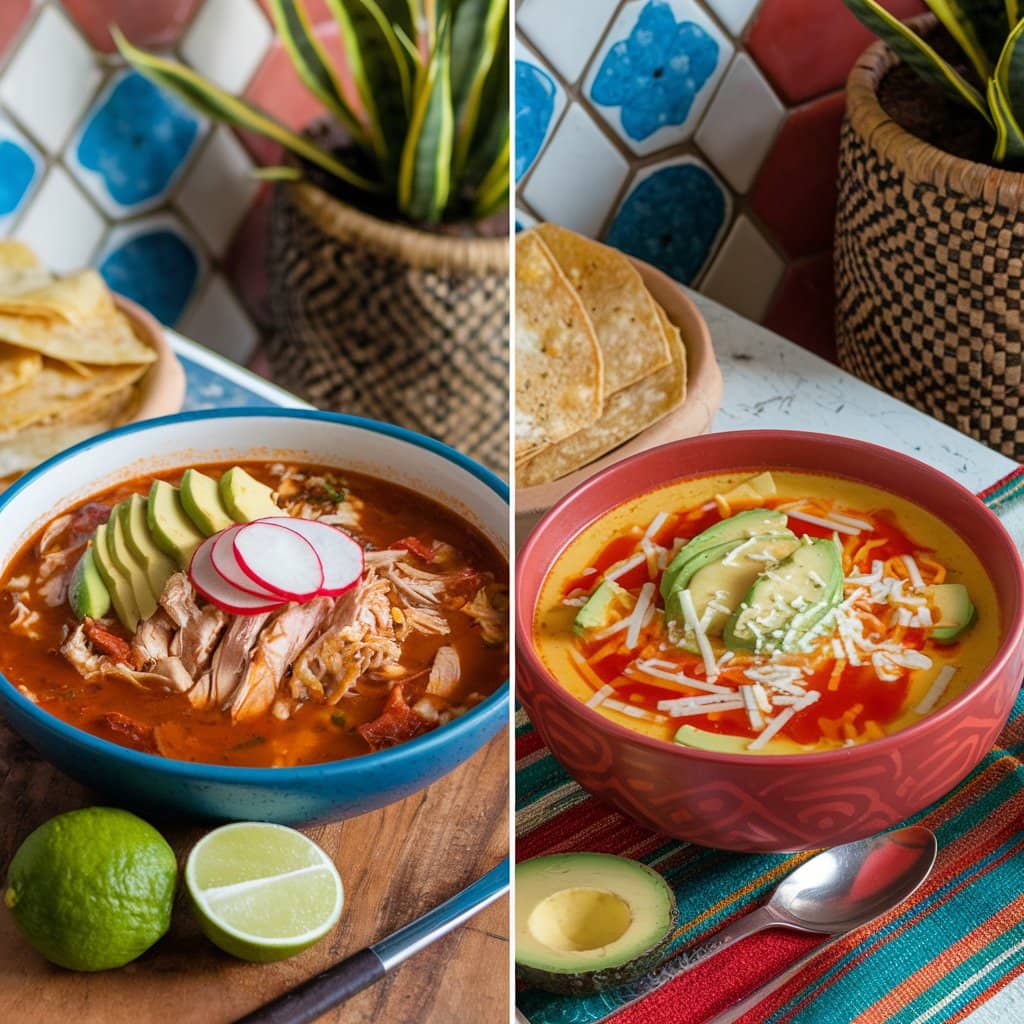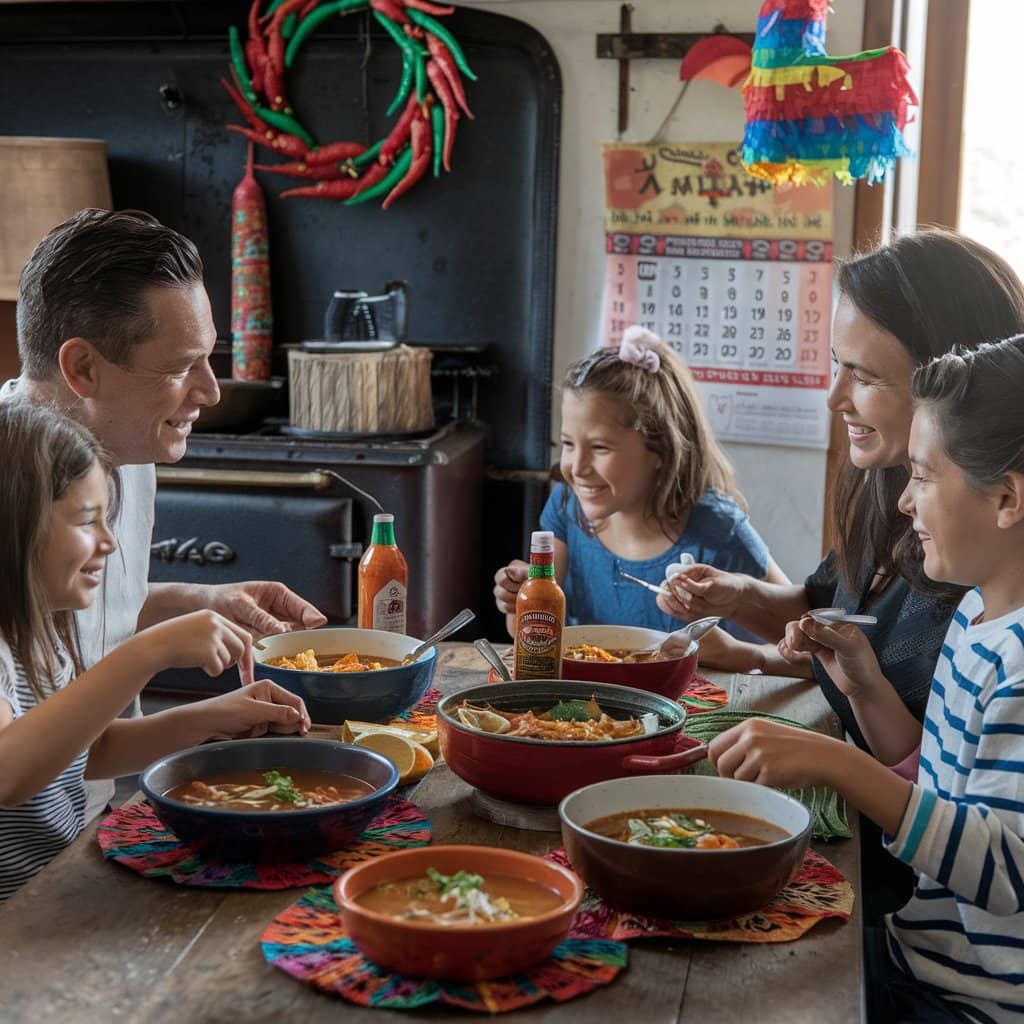Is Pozole the Same as Tortilla Soup? Mexican cuisine offers a vibrant array of dishes, with pozole and tortilla soup often standing out as comfort-food favorites. Despite their shared roots in Mexican culinary traditions, many people wonder if these two iconic soups are the same. While both are hearty, flavorful, and often served during special occasions or family meals, pozole and tortilla soup are distinct in terms of ingredients, preparation methods, and cultural significance. In this article, we’ll explore their unique characteristics, historical backgrounds, and key differences to help you appreciate each dish better.
Table of contents
What Is Pozole?
The History of Pozole
Pozole is a traditional Mexican stew that dates back to pre-Columbian times, particularly among the Aztecs and other indigenous peoples. It continues to be a staple in Mexican cuisine, especially during important holidays like Mexican Independence Day and Christmas.
Main Ingredients of Pozole
Hominy (processed corn kernels) forms the base of pozole, giving the dish its signature texture and flavor. The key ingredients typically include:
- Hominy: The star ingredient, offering a chewy texture.
- Cooks traditionally use pork for pozole, though some prefer chicken or beef as alternatives.
- Broth: A rich, flavorful base made by simmering meat with garlic, onions, and spices.
- Seasonings: Spices such as oregano, cumin, and chili peppers enhance the broth’s depth.
Types of Pozole
Pozole comes in three main varieties:
- Pozole Rojo (Red): Made with red chilies for a deep, smoky flavor.
- Pozole Verde (Green): Prepared with tomatillos, cilantro, and green chilies.
- Pozole Blanco (White): A simpler version with a clear broth and minimal seasoning.
How Cooks Prepare Pozole
To make pozole, cooks slow-cook the meat and hominy until tender. They season the broth with chilies, herbs, and spices to create a rich and savory dish. Once prepared, they serve pozole with toppings like shredded cabbage, radishes, lime, chopped onions, and tortilla chips for extra texture.

What Is Tortilla Soup?
The Origins of Tortilla Soup
Tortilla-soup, or “sopa de tortilla,” comes from central Mexico, particularly the state of Tlaxcala. Though its exact origins remain uncertain, many food historians believe people created the dish to repurpose leftover tortillas, transforming them into a flavorful and satisfying meal. Over the years, tortilla-soup has gained popularity as a beloved comfort food throughout Mexico and around the world.

Essential Ingredients of Tortilla Soup
Tortilla-soup is known for its light yet bold flavors, featuring a tomato-based broth enriched with Mexican spices. Key ingredients typically include:
- Tomatoes: The soup’s foundation, providing a rich and tangy base.
- Onions and Garlic: Essential aromatics that add depth.
- Chilies: Pasilla or guajillo chilies bring a smoky heat.
- Chicken Broth: A common base, though vegetable broth can be used for a vegetarian version.
- Tortilla Strips: Fried or baked strips of corn tortillas serve as the soup’s signature garnish.
Common Tortilla Soup Additions
Many variations of tortilla-soup include additional ingredients such as:
- Chicken: Shredded chicken is often added for extra protein.
- Avocado: Fresh slices for creaminess.
- Cheese: Queso fresco or Monterey Jack adds richness.
- Sour Cream: A dollop balances the heat.
- Cilantro and Lime: These fresh elements enhance the soup’s brightness.
How Tortilla Soup Is Made
To prepare tortilla-soup, cooks typically sauté onions, garlic, and chilies before blending them with tomatoes to create a smooth, flavorful base. They simmer this mixture with broth, adding seasonings like cumin and oregano for depth. Just before serving, they top the soup with crispy tortilla strips, avocado slices, cheese, and a splash of lime juice, turning every bowl into a burst of authentic Mexican flavors.
Key Differences Between Pozole and Tortilla Soup
While both pozole and tortilla-soup are iconic Mexican dishes, they differ in several key aspects, including ingredients, preparation methods, and overall flavor profiles. Understanding these distinctions helps highlight the unique culinary identities of each dish.

Ingredients Comparison
- Main Ingredient:
- Pozole: The star of pozole is hominy, a type of processed corn that adds a chewy texture.
- Tortilla-Soup: Tortilla strips play a central role, providing crunch and structure.
- Protein Choices:
- Pozole: Usually made with pork or chicken, though beef is an alternative.
- Tortilla-Soup: Commonly features shredded chicken but is also popular as a vegetarian option.
- Broth Base:
- Pozole: Has a rich, savory broth often flavored with garlic, oregano, and chilies.
- Tortilla-Soup: Boasts a lighter tomato-based broth with smoky chilies for depth.
Texture and Consistency
- Pozole: Thick and hearty due to the inclusion of hominy and tender meat. Its consistency is closer to a stew.
- Tortilla-Soup: Thinner and brothier, relying on toppings like tortilla strips and cheese for added texture.
Flavor Profiles
- Pozole: Offers bold, savory, and earthy flavors with a hint of spiciness, depending on the type of chilies used.
- Tortilla Soup: Tends to be lighter, tangier, and slightly smoky due to tomatoes and chilies. Fresh garnishes like lime and cilantro enhance its zestiness.
Presentation and Garnishes
- Pozole: Typically served with a range of toppings, including shredded cabbage, radishes, onions, lime wedges, and oregano.
- Tortilla Soup: Comes with crispy tortilla strips, avocado slices, cheese, sour cream, and fresh cilantro for a burst of color and flavor.
Cultural Context and Use
- Pozole: Considered a festive dish, often reserved for holidays and special gatherings.
- Tortilla Soup: A versatile, everyday meal that is quick and easy to prepare at home.
These essential differences reveal why pozole and tortilla soup, though both beloved Mexican dishes, offer entirely distinct culinary experiences.
Cultural Significance of Pozole and Tortilla Soup
Mexican cuisine showcases the country’s rich cultural heritage, with both pozole and tortilla soup playing significant roles in its culinary traditions. While pozole is closely linked to historical celebrations and festive gatherings, tortilla soup serves as a beloved staple in everyday Mexican households.
Pozole in Mexican Celebrations
- Historical Roots: Pozole has profound historical significance dating back to pre-Columbian times. It was traditionally consumed during sacred ceremonies by indigenous peoples such as the Aztecs, symbolizing abundance and community.
- Modern Celebrations: Today, pozole is often enjoyed during major Mexican holidays such as Mexican Independence Day, Christmas, and birthdays. Its preparation is time-consuming, making it a festive dish served on special occasions.
- Family Gatherings: Preparing pozole is a communal activity in many Mexican households, with family members contributing to various cooking stages. The act of sharing pozole strengthens social bonds and preserves culinary traditions.
Tortilla Soup as a Daily Staple
- Everyday Comfort Food: Tortilla soup is a versatile dish commonly prepared at home due to its simplicity and cost-effectiveness. It’s a popular option for quick lunches or light dinners.
- Cultural Representation: Though it lacks the ceremonial significance of pozole, tortilla soup still embodies the essence of Mexican home cooking. Its adaptability allows for countless variations, making it a household favorite.
- Street Food and Restaurants: Many Mexican restaurants feature tortilla soup on their menus, reflecting its widespread popularity. It’s also a common offering at street food stalls due to its easy preparation and satisfying taste.

A Culinary Symbol of Mexican Identity
Both pozole and tortilla soup showcase the rich culinary diversity of Mexico. Pozole represents historical roots and communal celebration, while tortilla soup symbolizes everyday comfort and practicality. Together, they reflect the deep cultural heritage, adaptability, and passion for flavorful cuisine that defines Mexican gastronomy.
Health Benefits and Nutrition
Pozole and tortilla soup are not only delicious but also offer nutritional benefits, depending on their ingredients and preparation methods. Let’s explore the health advantages of each dish and how they can be enjoyed as part of a balanced diet.
Nutritional Value of Pozole
- Protein-Rich: Pozole is typically made with pork or chicken, providing a good source of high-quality protein essential for muscle development and tissue repair.
- Fiber and Carbohydrates: Hominy, the key ingredient in pozole, is rich in fiber, which supports digestion and helps maintain a feeling of fullness.
- Vitamins and Minerals: Pozole contains essential vitamins like B6 and folate from corn, along with iron, zinc, and potassium from the meat and broth.
- Low in Fat (When Made Lean): Opting for lean cuts of meat and reducing added oils can make pozole a heart-healthy meal.
Nutritional Value of Tortilla Soup
- Low-Calorie Base: Tortilla soup’s tomato-based broth is naturally low in calories and packed with vitamins A and C from tomatoes and chilies.
- Healthy Fats: Ingredients like avocado and cheese provide heart-healthy unsaturated fats, which promote overall well-being.
- Protein Options: Adding shredded chicken boosts the protein content, making the soup a satisfying meal.
- Rich in Antioxidants: The combination of tomatoes, garlic, and chilies delivers a powerful dose of antioxidants that support immune health.
Health Considerations
- Watch the Toppings: While both soups are nutritious, adding excessive amounts of cheese, sour cream, or fried tortilla strips can increase calorie and fat content.
- Sodium Levels: Homemade versions allow for better control over sodium compared to restaurant-prepared dishes, which may contain high levels of salt.
- Portion Control: Serving moderate portions and balancing the soups with fresh vegetables or side salads can keep meals health-conscious.
Which Soup Is Healthier?
- For Weight Management: Tortilla soup may be a better option due to its lower calorie base, especially when prepared with minimal toppings.
- For Sustained Energy: Pozole, with its hominy and protein content, is excellent for sustained energy and post-workout recovery.
- Customizable for Health Goals: Both soups can be tailored to fit specific dietary needs by adjusting ingredients and preparation methods.
By understanding the nutritional profiles of pozole and tortilla soup, you can enjoy these delicious Mexican dishes while supporting your health goals.
How to Serve Pozole and Tortilla Soup
Serving pozole and tortilla soup properly enhances their flavors and presentation. Both dishes shine with the right toppings, sides, and drinks, creating an authentic Mexican dining experience.
1- Pozole
- Traditional Toppings:
- Shredded Cabbage or Lettuce: Adds crunch and freshness.
- Radishes: Thinly sliced for a peppery bite.
- Onions and Cilantro: Provide an aromatic boost.
- Lime Wedges: Squeezed over the soup for brightness.
- Oregano and Chili Flakes: Sprinkled on top for added flavor.
- Side Dishes:
- Tostadas: Crispy corn tortillas topped with beans or guacamole.
- Avocado Slices: Serve as a creamy side.
- Mexican Rice: Complements the hearty broth.
- Beverage Pairings:
- Agua Fresca: Refreshing drinks like hibiscus or tamarind water.
- Mexican Beer: Complements the rich flavors of pozole.
2- Tortilla Soup
- Essential Garnishes:
- Tortilla Strips: Fried or baked for crispy texture.
- Avocado Slices: Creamy and nutritious.
- Queso Fresco or Monterey Jack: Adds a mild, melty richness.
- Cilantro and Lime: For freshness and acidity.
- Sour Cream: A cooling contrast to the smoky broth.
- Side Dishes:
- Cornbread or Tortillas: Soft or grilled for dipping.
- Mexican Salad: A fresh mix of greens, tomatoes, and cucumbers.
- Beverage Pairings:
- Horchata: A sweet, cinnamon-flavored rice milk drink.
- Light Beer or Margarita: Balances the smoky and spicy flavors.
Serving Tips for Both Dishes:
- Presentation Matters: Use deep bowls for serving to keep the soups hot and enhance the visual appeal.
- Family-Style Setup: Offer toppings in separate bowls so guests can customize their portions.
- Warm Tortillas: Serve freshly made tortillas on the side for an authentic touch.
By following these serving suggestions, you can elevate your pozole or tortilla soup experience, impressing guests with authentic Mexican flavors and presentation.
Frequently Asked Questions (FAQs)
1. Is Pozole the Same as Tortilla Soup?
No, pozole and tortilla soup are different dishes. Pozole is a hearty stew made with hominy and meat (usually pork or chicken), while tortilla soup is a tomato-based soup with crispy tortilla strips and various toppings. Their ingredients, flavors, and cultural significance differ significantly.
2. Which Is Healthier: Pozole or Tortilla Soup?
Both can be healthy, depending on preparation methods. Tortilla soup is typically lower in calories due to its lighter, tomato-based broth. Pozole is more filling because of its hominy and protein content but can be higher in calories if made with fatty cuts of meat or topped with cheese and sour cream.
3. Can You Make Pozole and Tortilla Soup Vegetarian?
Yes, both dishes can be made vegetarian. Substitute the meat in pozole with beans or mushrooms and use vegetable broth. For tortilla soup, use vegetable broth and skip the chicken, focusing on tomatoes, chilies, and toppings like avocado and cheese.
4. What Are Common Toppings for Pozole and Tortilla Soup?
- Pozole: Cabbage, radishes, onions, lime wedges, oregano, and chili flakes.
- Tortilla Soup: Tortilla strips, avocado, cheese, cilantro, lime, and sour cream.
5. How Long Do Pozole and Tortilla Soup Last in the Refrigerator?
Both soups can be stored in the refrigerator for 3-4 days in an airtight container. Reheat over medium heat until warmed through. Add fresh toppings just before serving.
6. Can You Freeze Pozole or Tortilla Soup?
Yes, both soups freeze well. Allow them to cool completely before transferring them to freezer-safe containers. Avoid freezing toppings like avocado, sour cream, and tortilla strips, which are best added fresh.
Conclusion
While pozole and tortilla soup share a common heritage in Mexican cuisine, they are distinct in their ingredients, preparation, and cultural significance. Pozole, with its hearty hominy base and rich broth, is often reserved for special celebrations. Tortilla soup, with its light tomato-based broth and crispy tortilla strips, is a versatile dish perfect for everyday meals.
Understanding their differences helps appreciate the depth of Mexican culinary traditions. Whether you prefer the festive warmth of pozole or the comforting simplicity of tortilla soup, both dishes offer an authentic taste of Mexico’s rich and flavorful cuisine.

